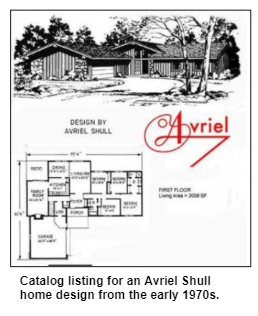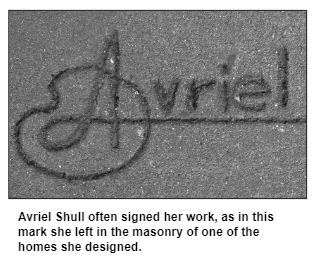Saturdays, noon to 1 p.m. ET on WICR 88.7 FM.
Or stream audio live from anywhere on WICR Online!
April 3, 2021
Avriel Shull, trail-blazing home builder and designer - encore
Click here to listen to the podcast.

Beginning in the 1950s, when women home builders were a rarity, Avriel Shull designed and built mid-century modern homes in Carmel, Indianapolis and other Hoosier cities. National periodicals eventually distributed the house plans of "Avriel" (she often was referred to by her first name only), with orders for her home patterns continuing long after she died in her mid-40s in 1976.
"Years before branding became an essential component of business success, Avriel was both a well-known company brand and a synonym for modern design," according to our guest, Connie Zeigler, owner of C. Resources, on this encore of a show originally broadcast in 2019. A historian, researcher and preservationist, Connie prepared the nomination for the National Register of Historic Places of the Thornhurst subdivision in Carmel, where Avriel designed 21 mid-century modern homes.

Just as Avriel's homes created something of a stir - with their floor-to-ceiling windows, sliding glass doors, vertical cedar siding and walled patios during an era noted for basic ranch houses - red-haired, charismatic Avriel drew attention on a personal level as well.
In 1951, Life magazine devoted a multi-page photo spread to her splashy wedding, during which Avriel entered amid a release of white birds; at 2 a.m., she lifted her white gown to perform the can-can.
Her husband was one of Indiana's best-known journalists of the era. An irreverent TV columnist for the Indianapolis News (and, before that, for the Indianapolis Times), R.K. Shull also answered reader questions in "Shull's Mailbag," which appeared in 260 newspapers across the country.
None of that overshadowed his wife, who, as Connie has written, "lived life at breakneck speed."
According to Connie, Avriel "often laid the stone herself on the houses she designed." As for an enduring architectural legacy, Connie notes that "At least 100, and probably more, of her houses are still standing in central Indiana."

In all of her Thornhurst subdivision houses - which were the focus of a 2017 home tour organized by the Carmel Clay Historical Society - Avriel featured modern fireplaces, some of which she built herself.
In a cover story about Avriel for a 2012 issue of Traces magazine published by the Indiana Historical Society, Connie notes that many of the fireplaces "had two-sided hearths opening into two different rooms."
Connie writes that for home interiors, Avriel chose vinyl-topped stools, tripod-legged lamps and sofas with hairpin legs, "unlike the ruffled sofas and overstuffed chairs of earlier eras." In many of the bathrooms, she painted murals - and added an elaborate "Avriel" as a signature to her work.
By the mid-1960s, Avriel landed contracts to design homes in upscale neighborhoods on the northside of Indianapolis including Avalon Hills, Crow's Nest, Meridian Hills and Sunset Lane. In the final years before her death just shy of her 45th birthday, Avriel was building houses in Brownsburg, Kokomo, Westfield and Evansville.
Our guest Connie Zeigler, after a long, influential career focused primarily on Indianapolis-area history and architecture, moved last month to Providence, R.I.
"I'll continue to do research and writing on a variety of design and architecture-related subjects," she reports, "including a book on several unheralded women designers married to well-known architects from the mid-20th century."

Nelson Price, host and historian
Molly Head, producer/general manager, (317) 927-9101
Mick Armbruster, associate producer
Cheryl Lamb, administrative manager
Richard Sullivan, senior tech consultant
Pam Fraizer, graphic designer
Garry Chilluffo, consultant
Please tell our sponsors that you appreciate their support!

 For organizational sponsorship, which includes logos, links, and voiced credits in the show and in podcasts, email molly@hoosierhistorylive.org, or call (317) 927-9101 for information. Our podcast listens are increasing and we are being distributed on Indiana Memory and the National Digital Public Library. Grow with us as our podcast and internet presence expands! Thanks also to Visit Indy, Fraizer Designs, WICR-FM, Henri Pensis, Genesis Brown, Kielynn Tally, Heather McIntyre, Justin Clark, and many other individuals and organizations.
For organizational sponsorship, which includes logos, links, and voiced credits in the show and in podcasts, email molly@hoosierhistorylive.org, or call (317) 927-9101 for information. Our podcast listens are increasing and we are being distributed on Indiana Memory and the National Digital Public Library. Grow with us as our podcast and internet presence expands! Thanks also to Visit Indy, Fraizer Designs, WICR-FM, Henri Pensis, Genesis Brown, Kielynn Tally, Heather McIntyre, Justin Clark, and many other individuals and organizations.
Thank you!
We'd like to thank the following recent, new and renewal contributors whose donations help make this show possible!
- John Stanton
- Kathleen Angelone
- Tim and Meg Shelly
- Connor & Company, Inc.
- Georgia Cravey and Jim Lingenfelter
- Ann Frick
- Yetta Wolen
- In memory of William G. "Bill" Mihay
- Dr. William McNiece
- Michael Freeland and Sharon Butsch Freeland
- David E. and Lynne J. Steele
- Stacia Gorge
- Margaret Smith
- Rachel Perry
- Tom and Linda Castaldi
- Greg Larson
- Marion Wolen
April 10, 2021 - coming up
The 25th Amendment, presidential succession and Indiana connections
Early this year, the 25th Amendment to the U.S. Constitution - which deals with presidential succession - was in the news when then-Vice President Mike Pence was urged to activate its provisions dealing with a president's being "unable to discharge the powers and duties of his office," because of Donald Trump's controversial behavior in the White House.
Indiana's links to presidential succession debates long pre-date Pence, a native Hoosier, and the late Birch Bayh, the three-term U.S. Senator from Indiana who crusaded for ratification of the 25th Amendment during the late 1960s. The line of succession in case of the death, disability or incapacity of a U.S. president had been unclear for more than 150 years prior to the amendment.
The connections to Indiana stretch back to the first president to die in office - William Henry Harrison in 1841 - and include such little-remembered episodes as the emergency surgery in 1902 for Theodore Roosevelt during a visit to Indianapolis. The use of anesthetic for Roosevelt at what was then known as St. Vincent's Infirmary (a historic marker in the Lockerbie neighborhood marks its initial site) raised issues about who should be in charge of the country if the president was unconscious.
In 1919, with still no procedure for determining the "inability" of a president, Vice President Thomas R. Marshall, who had been a popular governor of Indiana, found himself in an awkward position when Woodrow Wilson suffered a severe stroke.
To explore these and other historic links between presidential succession issues and Indiana, Nelson will be joined by two guests who have been researching the topic since the renewed public focus on the 25th Amendment:
- Norma Erickson, the director of medical education at the Indiana Medical History Museum. She will share insights about the health issues involved with some of the public figures, including William Henry Harrison, who had been the first governor of the Indiana Territory early in his political career. In recent years, new theories have been advanced about what may have caused Harrison's death after serving only one month in the White House. Unsanitary drinking water in Washington D.C. may have been a contributing factor.
- And Gary Shaw, a retired Indianapolis attorney and former deputy attorney general for the state. He will share insights about the predicament of Marshall, as well as the role of Bayh, whose interest in clarifying presidential succession was motivated primarily by the assassination of John F. Kennedy.
Copyright 2021
|








